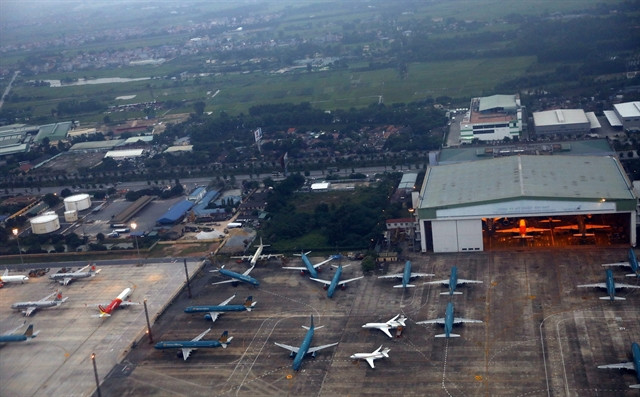 |
| A part of the aircraft parking lot in Nội Bài International Airport, Hà Nội. — VNA/VNS Photo |
A second airport in the capital region is expected to take shape by 2050 to ease the burden on busy Noi Bai International Airport, according to the Ministry of Transport.
Responding to the Hà Nội People’s Committee’s proposal on the building of the airport, the ministry said the construction matches Hà Nội’s development orientations by 2030 with a vision towards 2045, and the national master plan for 2021-2030 with a vision towards 2050.
The ministry said it will instruct relevant agencies to work on the location and planning criteria for the second airport, and report results to the Prime Minister for decisions.
The proposal on the airport’s function will be made based on study results on airspace, air routes and flight methods, the ministry said, citing the approved national airport system planning as that says domestic airports are allowed to serve irregular international flights.
The ministry may propose the Prime Minister convert domestic airports into international ones if air carriers desire to operate regular international flights and the infrastructure qualifies, he said, noting that the move aims to utilise the airport system, serve socio-economic development and ensure the flexibility and openness of the planning.
In the document, the ministry also asked the Hà Nội People’s Committee to soon specify the location for the second airport.
The planning scheme should be sketched out with the engagement of foreign consultants experienced in optimising airspace and ensuring flight safety, similar to what has been done in some of the airports in Việt Nam, the ministry said.
Planning
There are two proposed options in the general planning for the new airport.
The first option is to have the airport in Tân Ước and Thanh Vân communes (Thanh Oai District) and Tiền Phong and Tân Minh communes (Thường Tín District), which are only 20-30 km from the city centre, close to a number of expressways, the planned North-South high-speed rail line, and two metro lines in the works.
The land area for the airport is about 1,300 hectares, which requires the clearance of about two residential areas in Thanh Vân Commune. The 500kV power transmission line needs to be relocated outside the airport boundary.
The second option is a location in Đồng Tân, Minh Đức, Trầm Lộng, Kim Dường and Hoà Lâm (Ứng Hoà District). The advantage of this option is that the airport is located on the Southern axis of Hà Nội, connecting the central urban area with the second airport area.
It also links with the Phú Xuyên satellite urban area - industrial zone, a transportation hub, and a cargo transshipment hub to create motivation for the development of the southern region.
According to the People's Committee of Hà Nội, however, this option also requires further study and resolution of certain issues, such as upgrading the southern economic axis to an expressway to serve as the link with the second airport, as well as adding an urban railway line connecting Hà Đông area station to the airport.
The planned area for the second airport is located in seven communes, covering an area of about 1,700 hectares, affecting a population of approximately 10,000 people.
The 500kV power transmission line needs to be relocated, and noise pollution may affect the historical and scenic national relics of Hương Sơn, which are also problems with this option, according to Hà Nội’s authorities.
Hà Nội earlier stated that the second airport will be a domestic one, but will be fulfilling the requirements needed to become an international airport when necessary.
The airport is expected to serve some 30-50 million passengers a year, with the total land area needed at about 1300-1500ha.
According to national airport system planning for the 2021-2030 period with a vision until 2050, Việt Nam is set to have 30 airports by 2030, including 14 serving international flights and 16 serving domestic flights.
The investment is estimated at about VNĐ420 trillion (US$18 billion), mobilised from the State budget, non-budget capital and other legal capital sources.
Nội Bài International Airport is set to handle about 100 million passengers each year, equivalent to the capacity of Long Thành International Airport in the southern region and some big airports in the world. — VNS